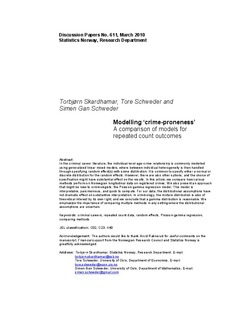| dc.contributor.author | Skarðhamar, Torbjørn | |
| dc.contributor.author | Schweder, Tore | |
| dc.contributor.author | Schweder, Simen Gan | |
| dc.date.accessioned | 2010-11-11T12:21:20Z | |
| dc.date.available | 2010-11-11T12:21:20Z | |
| dc.date.issued | 2010 | |
| dc.identifier.issn | 0809-733X | |
| dc.identifier.uri | http://hdl.handle.net/11250/180011 | |
| dc.description.abstract | In the criminal career literature, the individual-level age-crime relationship is commonly modelled using generalized linear mixed models, where between-individual heterogeneity is then handled through specifying random effect(s) with some distribution. It is common to specify either a normal or discrete distribution for the random effects. However, there are also other options, and the choice of specification might have substantial effect on the results. In this article, we compare how various methods perform on Norwegian longitudinal data on registered crimes. We also present an approach that might be new to criminologists: the Poisson-gamma regression model. This model is interpretable, parsimonious, and quick to compute. For our data, the distributional assumptions have not dramatic effect on substantive interpretation. In criminology, the mixture distribution is also of theoretical interest by its own right, and we conclude that a gamma distribution is reasonable. We emphasize the importance of comparing multiple methods in any setting where the distributional assumptions are uncertain. | en_US |
| dc.description.sponsorship | Financial support from the Norwegian Research Council and Statistics Norway is greatfully acknowledged. | en_US |
| dc.language.iso | eng | en_US |
| dc.publisher | Statistics Norway, Research Department | en_US |
| dc.relation.ispartofseries | Discussion Papers;611 | |
| dc.subject | Criminal careers | en_US |
| dc.subject | Repeated count data | en_US |
| dc.subject | Random effects | en_US |
| dc.subject | Poisson-gamma regression | en_US |
| dc.subject | Comparing methods | en_US |
| dc.subject | Tidsserier | en_US |
| dc.subject | Kriminalitet | en_US |
| dc.subject | Matematiske modeller | en_US |
| dc.subject | Jus | en_US |
| dc.subject | Kriminologi | en_US |
| dc.subject | JEL classification: C02 | en_US |
| dc.subject | JEL classification: C23 | en_US |
| dc.subject | JEL classification: K40 | en_US |
| dc.title | Modelling ‘crime-proneness’ : a comparison of models for repeated count outcomes | en_US |
| dc.type | Working paper | en_US |
| dc.subject.nsi | VDP::Social science: 200::Law: 340 | en_US |
| dc.subject.nsi | VDP::Mathematics and natural science: 400::Mathematics: 410 | en_US |
| dc.subject.nsi | VDP::Social science: 200::Criminology: 350 | en_US |
| dc.source.pagenumber | 29 | en_US |
